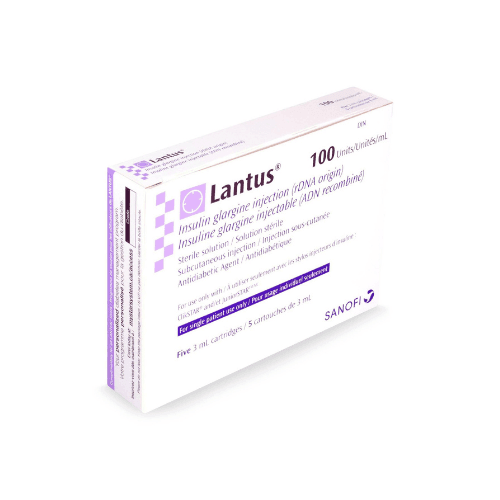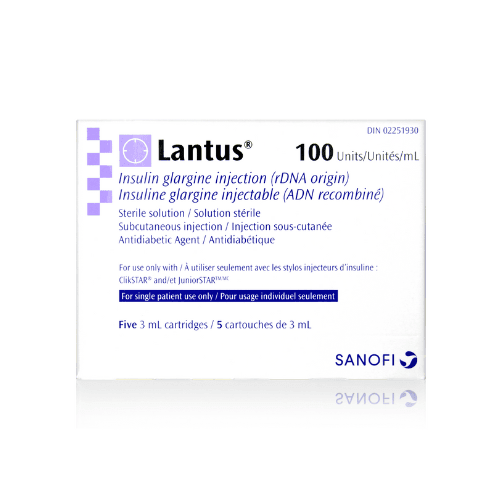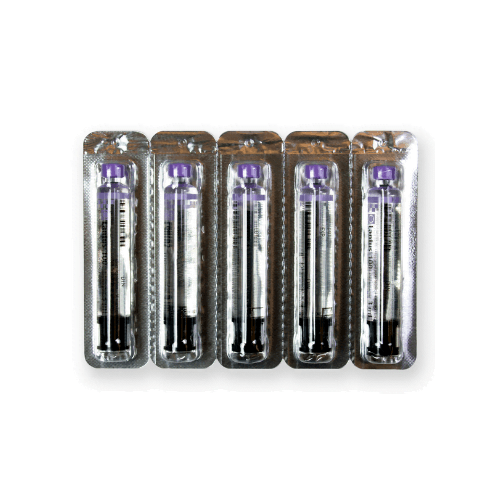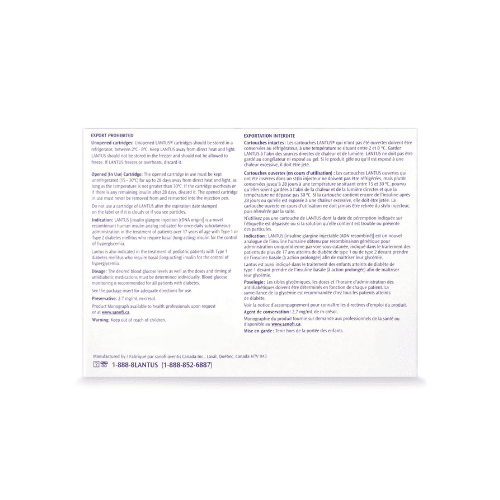Shipping with this method takes 3-5 days
Lantus® Cartridges for Diabetes
Stock up and Save - Get 20% off when you buy 3 or more of any one product. Use code SAVE20 at checkout.
Coupon code cannot be combined with other offers. Sale applies to all products originating from Canada. Maximum allowable quantity equal to a 90 day supply per single order.
$197.99
Secure Encrypted Payments
Lantus cartridges are a long-acting insulin option used to manage blood sugar in diabetes. This page explains how the therapy works, who it suits, and how to use it safely. You can review options with US shipping from Canada and see ways to budget, including Lantus cartridges without insurance.
What Lantus Is and How It Works
Lantus® contains insulin glargine, a basal insulin designed for steady, 24-hour background control. It releases slowly after subcutaneous injection, helping manage fasting and between-meal glucose. The formulation is intended to be taken once daily at the same time.
YouDrugstore is a licensed Canadian pharmacy in Manitoba. Pharmacists review prescriptions before dispensing.
As insulin glargine cartridges, this medicine is used in compatible reusable pens. It is not for insulin pumps or intravenous use. In type 1 diabetes, it is used with rapid-acting mealtime insulin. In type 2 diabetes, it can be used alone or with other antihyperglycemics when basal therapy is needed.
Who It’s For
This treatment is indicated for adults with type 1 or type 2 diabetes who need basal insulin. It is also approved for pediatric patients with type 1 diabetes when a long-acting background insulin is appropriate per the product label.
People with a history of severe hypersensitivity to any component should avoid it. Those with frequent hypoglycemia or significant renal or hepatic impairment may require closer monitoring. Discuss pregnancy and breastfeeding considerations with a healthcare professional to confirm suitability.
Dosage and Usage
Use once daily at the same time each day, as directed by your prescriber. Your dose is individualized based on blood glucose, prior insulin use, and clinical goals. For type 1 diabetes, a rapid-acting bolus insulin is also needed for meals. For type 2 diabetes, this basal insulin may be combined with oral agents or non-insulin injectables.
Inject subcutaneously in the abdomen, thigh, or upper arm. Rotate sites with each injection to reduce lipodystrophy and skin irritation. Do not inject into areas that are tender, bruised, or scarred. Do not dilute or mix with other insulins.
Follow pen-specific instructions for priming, dose dialing, and injection technique. Check your fasting readings regularly and follow your clinician’s guidance for any adjustments. If unsure about any step, consult the official patient leaflet and your pharmacist.
Strengths and Forms
This basal insulin is supplied as a 100 units/mL solution in 3 mL cartridges for use in compatible reusable pens. Availability can vary by region and manufacturer supply.
Lantus 3 mL Cartridges are typically sold in multiple-cartridge packs. Specific pack sizes and any local pack labelling may vary. Check the current product listing for what is in stock.
Missed Dose and Timing
If you miss a dose, inject as soon as you remember during the same day. If it is near the time of the next dose, skip the missed dose and resume your regular schedule. Do not take extra insulin to make up for a missed dose. Monitor your glucose and seek advice if you are unsure.
Storage and Travel Basics
Unopened cartridges should be stored refrigerated and protected from light. Do not freeze, and do not use if previously frozen. Once a cartridge is in use within a pen, keep it at room temperature as directed in the label and discard after the in-use period listed in official instructions.
Keep insulin away from excessive heat and direct sunlight. Cap the pen when not in use. For travel, carry your insulin and supplies in your hand luggage. Bring backup needles, a glucose meter, and low blood sugar treatment. A copy of your prescription and a letter for airport security may help. Use a cooler pack to keep insulin within label temperatures, avoiding direct contact with ice. Consider temperature-controlled handling when required.
Pen Handling and Sharps Disposal
Use only compatible reusable pens specified for this insulin. Before each injection, attach a new sterile pen needle, prime per the pen’s instructions, dial the prescribed units, and inject subcutaneously. Do not share pens or needles.
Use BD Nano Pro or another compatible pen needle size as directed. Ensure you can read the dose window clearly before injecting. After use, remove the needle carefully and place it in a puncture-resistant sharps container. Follow local guidance for disposal.
These insulin glargine 3 mL cartridges should not be transferred with a syringe or used outside a compatible pen system.
Benefits
This long-acting insulin offers steady, once-daily basal coverage. It supports consistent fasting glucose control with a stable activity profile. Using a reusable pen can reduce plastic waste compared to disposable pens and may help with fine dose adjustments, depending on the device.
Side Effects and Safety
- Low blood sugar: shakiness, sweating, dizziness, headache
- Injection site reactions: redness, itching, swelling
- Weight gain or fluid retention
- Skin changes at injection sites
Serious reactions can include severe hypoglycemia, generalized allergy, or hypokalemia. Edema may occur, especially with certain concomitant drugs. Seek urgent help for signs of anaphylaxis, severe low glucose, or persistent swelling.
The risk of hypoglycemia can rise when used with prandial insulin or sulfonylureas. Monitor regularly and discuss concerns with your prescriber.
Drug Interactions and Cautions
Medicines that may increase the blood glucose–lowering effect include other insulins, GLP‑1 receptor agonists, and some antihypertensives. Agents that may reduce the effect include corticosteroids, some diuretics, and certain antipsychotics. Beta blockers can mask low glucose warning symptoms such as tremor or tachycardia. Alcohol intake can unpredictably affect glucose.
Changes in kidney or liver function can alter insulin needs. Illness, stress, or changes in activity or diet may also impact requirements. Always review your complete medication list with your healthcare professional.
What to Expect Over Time
It may take several dose adjustments to reach your target fasting range. Many people see smoother overnight readings once a stable routine is established. Keep a consistent injection time, track fasting glucose, and bring records to follow-up visits. If your daily schedule changes, discuss options for timing with your prescriber.
For broader diabetes support, see our condition pages for Type 1 Diabetes and Type 2 Diabetes. You might also find our guide on lifestyle helpful: Reverse Prediabetes.
Compare With Alternatives
Other long-acting options include biosimilar glargine and insulin detemir. Your prescriber may recommend an alternative if device preference, availability, or prior response suggests a better fit. Two options we stock:
- Basaglar Cartridge (insulin glargine)
- Levemir Penfill (insulin detemir)
Pricing and Access
You can review the Lantus cartridges price on our product page and compare options. Many customers use Canadian pricing with US delivery from Canada to help manage budgets. If you’re looking for extra ways to save, check our current offers here: Promotions. Final amounts depend on pack size and your prescription details.
For a refill-friendly experience, add the item to your account, set reminders, and choose the quantity that aligns with your care plan.
Availability and Substitutions
Supply can vary. If the requested pack is unavailable, your prescriber may recommend a similar basal insulin or a different device format. Some markets list the pack as Lantus Cartridge 5×3 mL; availability depends on current stock.
If you need alternatives or compatible supplies, explore our Diabetes Care category for meters, pen needles, and support items.
Patient Suitability and Cost-Saving Tips
Good candidates are those who benefit from a once-daily basal regimen and can handle pen technique. People with frequent severe lows, recurrent site problems, or limited ability to monitor may need a different plan or extra support. If you are uncertain, ask your clinician to review your logs and device preferences.
To save on out-of-pocket costs, consider multi-month quantities when appropriate, coordinate refills before travel, and store supplies properly to avoid waste. Keep your monitoring supplies on hand to prevent emergency purchases.
Questions to Ask Your Clinician
- Is a once-daily basal insulin the right fit for me?
- How should I adjust around travel or shift work?
- What signs of low blood sugar should I watch for?
- Which injection sites are best for me, and how should I rotate?
- How will other medicines affect my insulin needs?
- What device training do I need for my pen?
Authoritative Sources
Ready to proceed? Add to cart and follow checkout for express, cold-chain shipping. Ships from Canada to US. This information is not a substitute for medical advice. Always follow your prescriber’s instructions and the official label.
Express Shipping - from $25.00
Prices:
- Dry-Packed Products $25.00
- Cold-Packed Products $35.00
Shipping Countries:
- United States (all contiguous states**)
- Worldwide (excludes some countries***)
Standard Shipping - $15.00
Shipping with this method takes 5-10 days
Prices:
- Dry-Packed Products $15.00
- Not available for Cold-Packed products
Shipping Countries:
- United States (all contiguous states**)
- Worldwide (excludes some countries***)
Can I switch from another basal insulin to this one?
Switching between long-acting insulins should be guided by your prescriber. Products differ in onset and duration, and your dose may not be 1:1. Your clinician will consider your current regimen, glucose patterns, and hypoglycemia risk. Monitor closely after a change. Review the official patient information and contact your pharmacy or healthcare professional if you have questions during the transition.
How should I monitor while starting a new cartridge?
Track fasting readings daily and log any nighttime symptoms. Keep notes on meals, activity, and any lows. Bring your records to follow-up appointments so your clinician can assess patterns. If your readings are consistently off target, contact your healthcare professional for guidance. Do not change your dose on your own unless your prescriber has provided a written plan.
What if my injection site is irritated?
Rotate sites with each dose and avoid areas that are tender or scarred. Use a new sterile needle every time. Mild redness often settles, but persistent swelling, warmth, or pain should be reviewed by a clinician. If you notice lumps or skin changes, rotate away from those areas. Seek urgent help for signs of infection or a severe allergic reaction.
Can I use the cartridges with any pen?
Only use pens that the label lists as compatible with the cartridge format. Mixing devices can cause dosing errors, leakage, or breakage. Check your pen’s instructions before loading a new cartridge. If unsure which pen to use, ask your pharmacist to confirm compatibility and demonstrate safe loading, priming, and dose dialing.
How do illness and stress affect my insulin needs?
Illness, fever, or major stress can change insulin requirements. You may see higher or lower readings depending on hydration, appetite, and activity. Check your glucose more often and follow any sick-day guidance your clinician has provided. Seek medical advice if your readings remain high or you have repeated lows, ketones, or vomiting.
What should I know about alcohol use with basal insulin?
Alcohol can unpredictably lower or raise glucose, and it may increase the risk of delayed hypoglycemia, especially overnight. If you drink, do so with food, monitor more often, and be cautious about bedtime levels. Discuss individualized guidance with your prescriber and know the signs of low blood sugar so you can act quickly if needed.
How do I travel with insulin and supplies safely?
Keep insulin and needles in your carry-on. Pack extra supplies, including a meter, test strips, and hypoglycemia treatment. Use a protective case or cooler pack to avoid temperature extremes. Bring your prescription and a letter for security if possible. Check time zones to maintain a consistent dosing routine, and plan ahead for refills if you will be away longer than expected.



